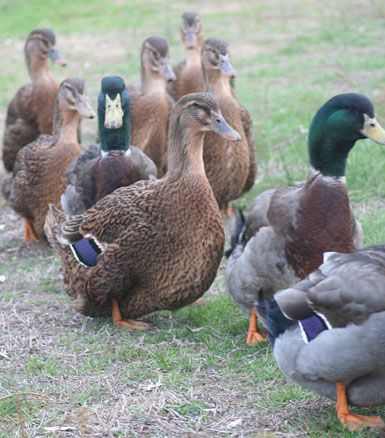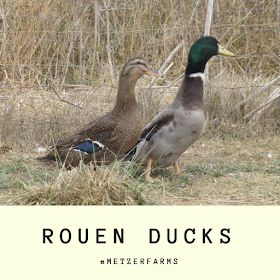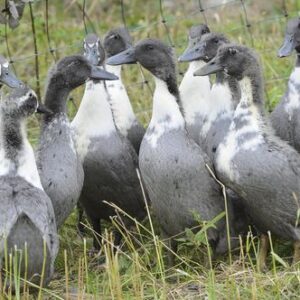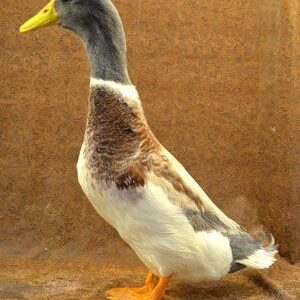The Rouen Duck is a large, domesticated breed of duck (Anas platyrhynchos domesticus) renowned for its stunning plumage, calm demeanor, and utility in meat production. Originally developed in France, the breed has gained popularity worldwide for its striking resemblance to the Mallard duck, combined with its larger size and more docile nature. Rouens are a versatile breed, valued for their beauty, meat quality, and ornamental presence in farmyards, ponds, and backyards.
Physical Characteristics
The Rouen Duck is easily recognized by its size and vibrant Mallard-like coloring.
- Size: Rouen ducks are significantly larger than Mallards. Adult males typically weigh between 8–10 pounds (3.6–4.5 kg), while females weigh around 7–9 pounds (3.2–4.1 kg).
- Plumage:
- Drakes (Males): Drakes have glossy green heads, a white ring around their necks, and rich chestnut-brown breasts. Their bodies are predominantly gray with hints of blue and black in the wings and tail.
- Hens (Females): Females display mottled brown plumage, providing excellent camouflage and a more subdued but equally attractive appearance.
- Bill and Legs: Drakes have yellow or greenish bills, while females have duller orange or brown bills. Both sexes have orange legs and feet.
- Carriage: Rouens are heavy-bodied with a horizontal stance, contributing to their graceful and sturdy appearance.
Behavior and Temperament
Rouen ducks are known for their calm, friendly demeanor, making them a great choice for small farms, backyards, or as ornamental birds.
- Docile Nature: Rouens are gentle and easy to manage, even for novice keepers. They tend to be less flighty than lighter duck breeds.
- Social Creatures: They thrive in groups and enjoy the company of other ducks. Their calm temperament makes them ideal for mixed flocks.
- Non-Flyers: Due to their size, Rouens are not capable of sustained flight, which makes them easy to contain and manage.
Egg Production
While Rouens are not primarily raised for their eggs, they are moderate layers and can contribute to egg production on a small scale.
- Egg Output: Females typically lay 35–125 eggs per year, depending on care and environmental conditions.
- Egg Color and Size: Eggs are usually white, though they can sometimes have a pale blue or green tint. They are medium to large in size.
- Broodiness: Rouen hens can occasionally go broody and are attentive mothers if allowed to hatch their eggs.
Meat Production
Rouen ducks are primarily bred for their meat, which is highly prized for its flavor and quality.
- Meat Quality: Rouen meat is rich, tender, and flavorful, with less fat than some other breeds, making it a delicacy in gourmet cooking.
- Growth Rate: Unlike some meat breeds, such as Pekins, Rouens grow at a slower rate, taking about 6–8 months to reach full size. This slower growth contributes to their superior meat quality.
Habitat and Care
Rouen ducks are hardy birds that adapt well to various climates and conditions, provided they are given proper care.
- Space Requirements: Due to their large size and foraging habits, Rouens benefit from access to spacious enclosures with room to roam and forage.
- Water Access: While they do not require a large pond, Rouens enjoy having access to water for swimming and preening. A kiddie pool or shallow water source is sufficient.
- Shelter: They need a secure, dry shelter to protect them from predators and extreme weather. Straw or wood shavings make excellent bedding.
- Diet: Rouens thrive on a diet of grains, greens, and commercial waterfowl feed. They are also excellent foragers and will eagerly consume insects, snails, and vegetation.
History and Origin
The Rouen Duck has a long and rich history, tracing its origins back to France.
- Development: The breed was named after the French city of Rouen and was originally bred as a larger version of the Mallard for meat production.
- Introduction to England and America: Rouens were introduced to England in the 19th century, where selective breeding refined their size and plumage. They later gained popularity in the United States for their utility and beauty.
- Exhibition Ducks: Over time, two distinct types of Rouens emerged—production Rouens for meat and show Rouens bred for exhibition standards.
Conservation and Popularity
The Rouen Duck is widely appreciated but is considered less common than faster-growing meat breeds like the Pekin.
- Conservation Status: While not endangered, conservation efforts focus on preserving the breed’s unique characteristics and maintaining genetic diversity.
- Popularity: Rouens remain a popular choice for small-scale farmers, hobbyists, and those who value their ornamental beauty and flavorful meat.
Uses and Benefits
Rouen ducks serve multiple purposes, making them a versatile addition to any flock.
- Meat Production: Their flavorful, tender meat makes them a favorite for gourmet dishes.
- Ornamental Value: Their vibrant plumage and large size make them an eye-catching addition to any backyard or pond.
- Pest Control: As active foragers, Rouens help manage garden pests, including insects and snails.
- Egg Production: While not prolific layers, they contribute to egg production in mixed-purpose flocks.
Conclusion
The Rouen Duck is a remarkable breed that combines elegance, utility, and adaptability. Its stunning Mallard-like appearance, friendly temperament, and high-quality meat production make it a favorite among backyard poultry enthusiasts and small-scale farmers. Whether gracing a pond, providing gourmet-quality meat, or serving as a charming companion, the Rouen Duck is a versatile and treasured addition to any flock.









Reviews
There are no reviews yet.